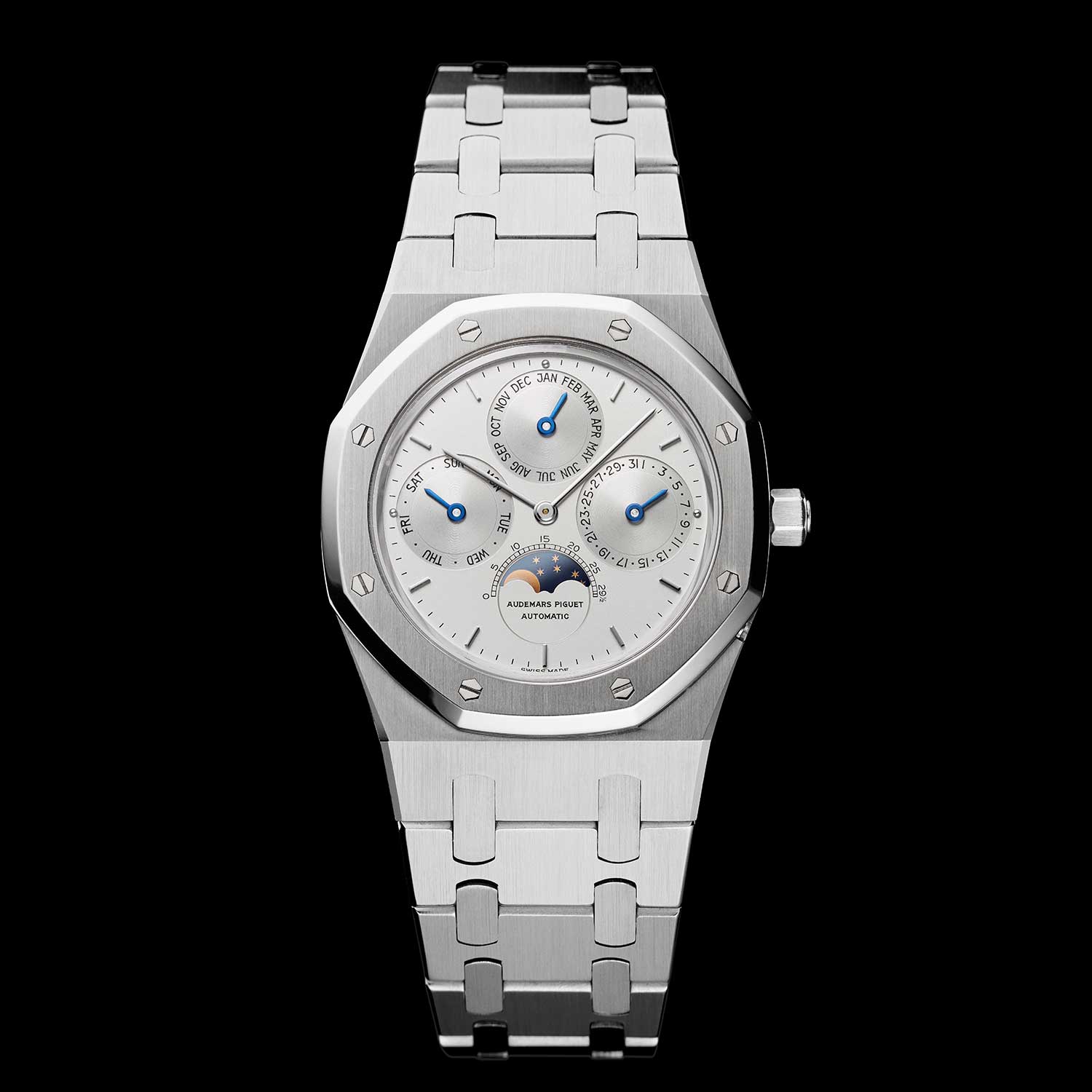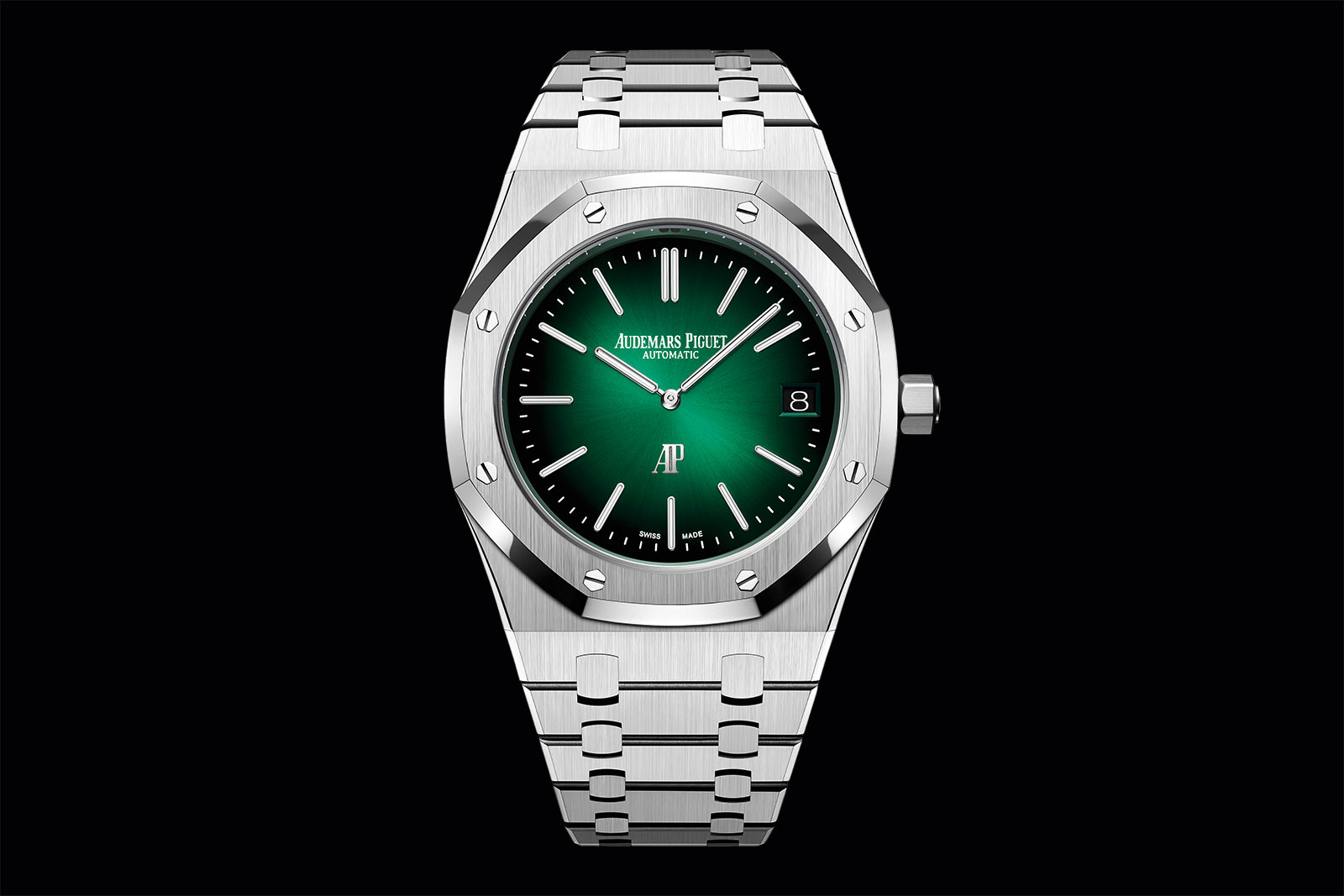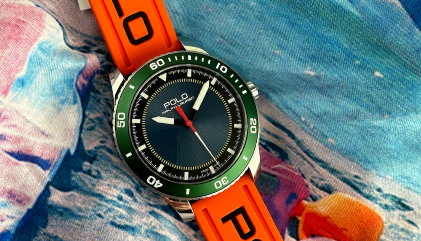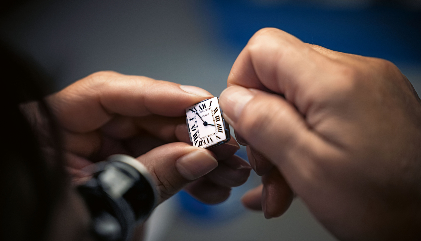A storied watch brand at the brink of collapse. A design that was made overnight. A new category of timepieces created. A watch that acquired cult status. That, in a nutshell, is the story of the success of Audemars Piguet’s Royal Oak line. But oversimplification is hardly the route to take in understanding why the Royal Oak today is a grail watch; gets the highest bids at auctions; has an unending wait-list; and is a favourite of most celebrities. The Royal Oak’s story is to be savoured, applauded, even envied a little bit. Because when it launched in 1972, its octogonal bezel with eight visible screws and an integrated bracelet set a new epoch in watch design.
Also Read | The 101 On The Peripheral Rotor. And The Watches That Have It
Created by legendary timepiece designer Gérald Genta, the Royal Oak is considered to be the first luxury sports watch in the world. Inspired by diving helmets, legend has it that Georges Golay, then managing director of Audemars Piguet, had called on Genta on the eve of the Basel Watch Fair to create a fresh category of fine watches that would appeal to a new generation of clients. The Swiss industry was in the throes of the Quartz Crisis maelstrom, and Audemars Piguet needed a win. And Genta’s design, unveiled the next day at the Basel Watch Fair and unlike any seen before, would deliver.
Here was a steel watch at time when luxury timepieces were crafted in gold or platinum. Its integrated bracelet, which decreased in thickness towards the clasp, was an anomaly. At 39mm, it was bigger than most timepieces of the day (it eventually led to people referring to it as ‘Jumbo’), but also thin at 7mm. Its hand-polished and satin-brushed finishing reinforced the watch’s aesthetic lines, and it was fitted with the self-winding Calibre 2121, the world’s thinnest self-winding movement at the time, beating at 19,800 vph (5.5Hz), with date indication, and an overall height of 3.05mm. It was named after historical British warships. Everyone took notice.
When it hit stores, the Royal Oak was priced CHF 3,650, more than the price of a gold Patek Philippe and 10 times more than the cost of a Rolex Submariner back then. It took the company nearly four years to sell the first 1,000 pieces. But past the initial bleak commercial response, Audemars Piguet’s Royal Oak stood out for the fact that it drastically upended the prevailing design codes of watchmaking. Not only did it go on to become a mammoth success with innovations and complications aplenty, but also created a new category of timepieces. As it celebrates 50 years in 2022, we pick out seven Royal Oaks that personify the audaciousness of the line.
Royal Oak Ref 5402, 1972
The stupendous work of Gérald Genta, who was already credited for designing watches for Universal Genève (Polerouter Microtors, White Shadow, Golden Shadow), Omega (Constellation), and Patek Philippe (Golden Ellipse), and went on to design the Patek Philippe Nautilus (1976), is incomparable. In the Royal Oak, he created the first high-end sports watch, with an angular appearance in contrast to the prevailing aesthetics of the time, i.e, warm colours and curved shapes.
Audemars Piguet built a first series of 1000 pieces, which is known to collectors as the A-series of Reference no. 5402. It took more than one year for Audemars Piguet to sell all the first 1000 Royal Oaks. Even after selling them, Audemars Piguet still used A serial number for the next batch of 1000 watches, before coming to B and C serial numbers.
The A series was created to be an everyday watch rather than just for specific occasions. The 39mm case featured an exclusive blue petit tapisserie motif on the dial, along with a date aperture at 3 o’ clock. It was powered by the ultra-thin Calibre 2121, derived from Jaeger-LeCoultre’s 920 Calibre movement. Aesthetically speaking, the design had both satin and polished finishes on the bracelet to give the watch a three-dimensional look. It is still the most sought-after Royal Oak by collectors, recognised easily by the AP initials placed above 6 o'clock rather than at 12 o'clock.
First Royal Oak Perpetual Calendar 5554 (later 25554), 1984
Created and offered to public in 1984, the 5554 Perpetual Calendar is one of Audemars Piguet’s cult models to this date. (Side note: So far, the brand has done three categories of perpetual calendars. The first category are the non-leap year indicator timepieces created from 1984 to 1993; then come the leap-year indicator watches from 1995 to 2014 – both sets were a 39mm. Finally, from 2015 till date, the case was made a 41mm, and received a thicker movement).
Similar to the Ref 5402, the Ref 5554 - 25554 was 39mm wide, 7.5mm thick, and, aside of the dial, looked like any other Royal Oak. The hands at 12 o' clock donned the month indicator; 3 o'clock had the date indicator; 6 o 'clock combined running seconds and moon-phase, and nine o'clock sported the day indication. Designed by Jacqueline Dimier, a protégé of Genta, in their original expression each 5554 came with a ‘Mark 1’ dial (which differed from the subsequent ‘Mark 2’ dial). This referred to the size of the 'Audemars Piguet' signature on the dial - while the Mark 1 used a smaller font for the signature, Mark 2 used a larger font. The Mark 1 dials were embellished in grey opaline finish. Just 279 pieces ever made, and out of those, 229 were made in yellow gold, and one timepiece made in titanium while the rest were made in stainless steel.
The First Royal Oak Offshore, 25721 (1992)
While the Royal Oak line turned 20 in 1992, it was the year after when the commemorative timepiece, the Royal Oak Offshore, was unveiled. However, the name ‘Offshore’ didn’t appear on the watch in the initial stages, as the Swiss manufacturer was skeptical of using it; the first 100 models only bore the ‘Royal Oak’ on the caseback, with the 101st model flaunting an engraved ‘Royal Oak Offshore’.
Measuring 42mm and with a thickness of 16mm, the Royal Oak Offshore was nicknamed ‘The Beast’, and was the first oversized luxury sports watch from the Swiss manufacturer. The watch came with a glare-proof sapphire crystal, and it started with a stainless steel iteration. Rubber was used for the crown and pushers, and there was a visible gasket between case and bezel. The dial of the watch consisted of a Tapisserie pattern, and with the heavy stainless steel bracelet, the watch weighed approximately 223 grams. Powering the watch was a caliber 2126/2840 and a soft-iron plate was placed beneath the dial and soft-iron internal case protected the motion from being exposed to magnetic fields. The watch was designed by Emmanul Gueit; reportedly, Genta publicly declared that he disliked the design.
Royal Oak Concept (2002)
Launched to commemorate the 30th anniversary of the Royal Oak, this rare Ref. 25980AI was a ‘lab watch’, the first-ever to have a case crafted from a superalloy from the aviation industry, Alacrite 602, the hardest material available at the time. This played into the brand’s idea of creating a futuristic timepiece, one which even moved away from the design of both the Royal Oak and the Royal Oak Offshore. Designed by Claude Emmenegger, who was the head of creation at that time at Audemars Piguet, the watch had a case measuring 44mm.
With the core of a Royal Oak, eight visible hexagonal screws, and the sapphire crystal, the ‘lab watch’ had a water resistance of 500 metres and an intuitive handling system activated by a pushpiece in synchronisation with the crown.
Extra Thin Jumbo Iterations
The Royal Oak Extra Thins have their own legion of followers, and even within this microcosm, some references stand apart. First of them is the Royal Oak Extra-Thin Jumbo ref. 15202ST, first launched in 2012 to make the 40th anniversary of the Royal Oak. The watch inspired by the original 5402 featured a 39mm case, and brought back several elements from the original ‘72 version, including the Audemars Piguet logo at 6 o’clock and the double index markers at 12 o’clock with an all new black date wheel. The Royal Oak Extra-Thin Jumbo ref. 15202ST will be discontinued this year. This timepiece had a blue dial with ‘Petite Tapisserie’ pattern and was finished with an integrated stainless steel bracelet with AP folding clasp. Donning the original 39mm diameter, powering the watch was the calibre 2121 (the same that was in the original iteration), measuring just 3.05mm and delivering a 40-hour power reserve with a 2.75 Hz frequency. The movement is still one of the thinnest automatic movements, fitted with a rotor, sitting on a beryllium ring backed by four ruby rollers.
Another much-loved Extra Thin Jumbo is the Ref. 15202BC ‘Salmon dial’ launched in 2019. Featuring a pink gold-toned ‘Petite Tapisserie’ dial, which first appeared in 1992, this design had an 18K, white gold case and bracelet. Powering this watch was a 2121 movement offering a power reserve of 40 hours and was limited to only 75 pieces in the year 2019.
Completing the troika is the Jumbo Extra-Thin Ref. 5202PT released in 2021, the watch comes in a 950 platinum case, a 39mm diameter. So, if you are one of those people who just love the colour green, this watch is meant for you. Bestowed with a smoked green dial, it is truly one of the hottest variants in the range. The watch is powered by the same self-winding 2121 calibre, and has a water resistance of 50 metres.
Royal Oak Concept Supersonnerie Ref 26577, 2016
Often considered as one of the most advanced concept watch of modern times, Royal Oak Supersonnerie took almost eight years to create – it is simply a power precision sound box on wrist. Launched in 2016, the watch comes as a minute repeater with two gongs, a tourbillon, and a chronograph with central sweep-seconds hands. Encased in a super light titanium case with a black skeletonised dial, this 44mm behemoth of a timepiece had a titanium bezel, titanium caseback with openings working as a resonance chamber, titanium pusher guards, and a black ceramic screw-down crown. The sand-blasting process on the case gave this watch an ultra matte finish, along with a satin-brushed finish on the case band. The watch came with a water resistance of 20 metres. The sapphire glass made this watch extremely strong and resistance to scratches. Power came from Audemars Piguet Calibre 2937 handwound movement, and had a 42-hours power reserve. The watch was finished in a black rubber strap with titanium AP folding clasp.
Audemars Piguet Royal Oak Perpetual Calendar Black Ceramic, Ref 26579CE, 2017
Ceramic has always been the preferred material at Audemars Piguet, and the Royal Oak Perpetual Calendar Black Ceramic’s every inch was cloaked in black ceramic. The 41mm black ceramic watch requires more time to make in comparison to the stainless steel version. While the stainless steel version would take close to six hours to finish, the black ceramic variant would take almost 30 hours for the final product. With the exact same measurements, the black ceramic version weighs a lot lighter at 126.9 grams.
The dial is made in dark grey with black subdials to match the ceramic case. The black ceramic perpetual calendar is powered by the calibre 5134, a movement based on the ultra-thin calibre 2120/2121 found in the ‘72 Royal Oak. In fact, this calibre is derived from the 2120/2802 calibre that was found in the 39mm perpetual calendar, the only difference being the addition of a 52 week indicator. The watch gets a water resistance of 200metres.
All Image: Courtesy Audemars Piguet























